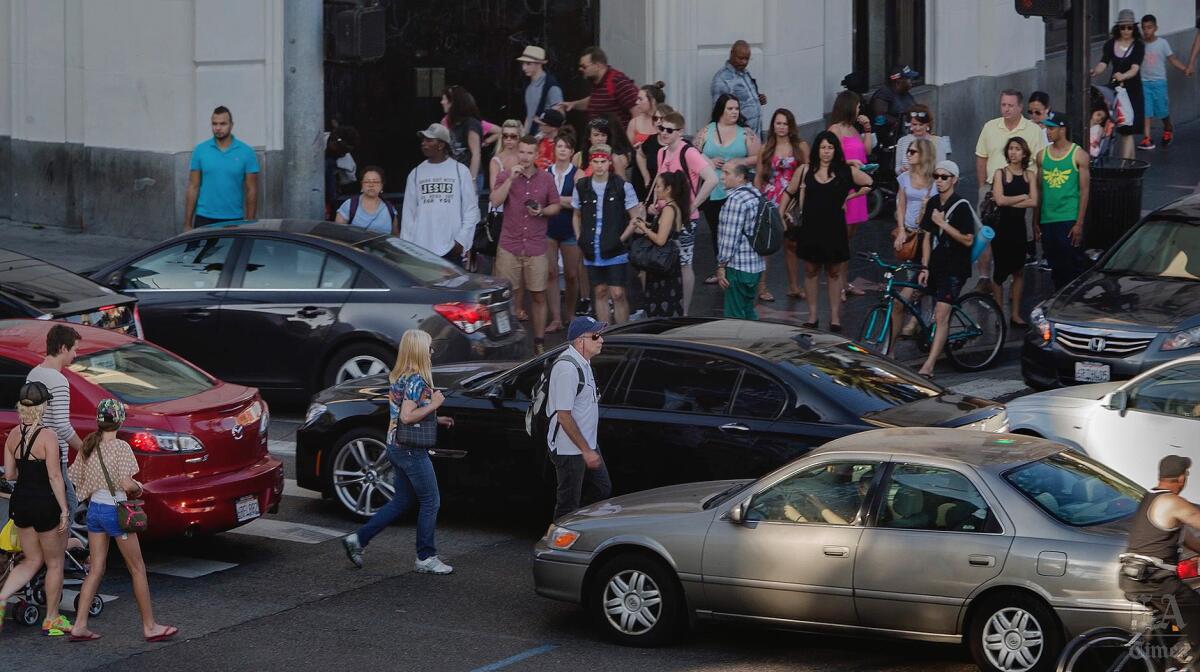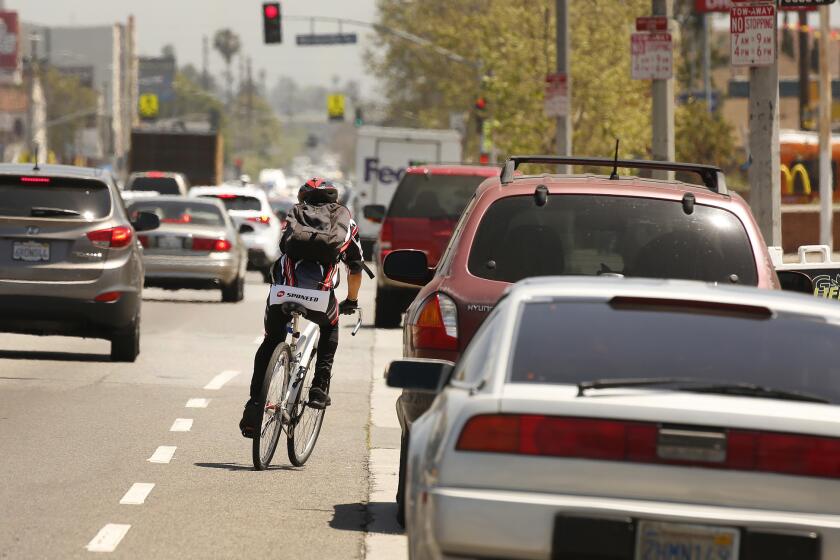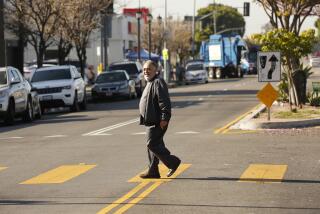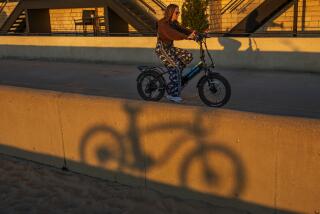Pedestrians die every 90 minutes in the U.S., and low-income areas are hurt most
The memorial to Christian Vega near a busy Los Angeles intersection is a serene arrangement of flowers and votive candles offset from the busy sidewalk by a row of bushes.
Erected where Riverside Drive and Newell Street meet, it is the second memorial for Vega. The first was flattened by a car that jumped the curb as it sped around the corner, spilling red roses like blood just yards from where a Toyota Camry struck the 17-year-old on a rainy night in February.
The car that hit Vega deposited his body more than a hundred feet from the crosswalk on a stretch of Riverside that residents in the Elysian Valley neighborhood have long felt was dangerous.
“It was a pain that was so big that I can’t explain it,” said his mother, Anni Baltierra. “It feels like they took a part of my body and they’re never giving it back.”
Vega’s fate is numbingly commonplace. He is part of a growing epidemic of pedestrian deaths on American roadways that occur once every 90 minutes.
On a clear afternoon last April, Frederick Frazier was riding his bike in South Los Angeles, headed to help a friend fix a flat tire, when a driver in a Porsche Cayenne rear-ended him.
The troubling national trend has perplexed advocates and experts, while disproportionately affecting lower-income, minority communities — neighborhoods that have roads designed to move vehicles quickly, with little thought to those who rely on walking or public transportation.
After more than 30 years of declining pedestrian fatalities, the number began to climb in 2010. Nearly 40,000 pedestrians have died since, according to federal data. Numbers are not yet available for 2018, but the death count is projected to hit more than 6,000. That would make it the deadliest year in nearly three decades, according to the Governors Highway Safety Assn.
“It’s an embarrassment to our country,” said Richard Retting, a transportation engineer and consultant with Sam Schwartz Engineering who wrote the association’s 2018 pedestrian fatality report.
Elsewhere, pedestrian deaths are dropping. In the early 2000s, the European Union began requiring automakers to pass pedestrian safety tests before they could sell vehicles in Europe. The regulations spurred design changes, and pedestrian fatalities declined by 36% in the EU from 2007 to 2016. Japan adopted similar regulations. It too has seen pedestrian deaths drop.
The same approach in the U.S. could save countless lives, experts say.
“It doesn’t make sense for 6,000 people to go out for a walk and not come home,” said Retting, whose grandfather died on one such walk decades ago. “I know the impact that has on a family.”
A substantial increase in the millions of miles driven annually has led to small increases in all roadway fatalities in recent years. But for those inside the vehicles, roads have never been safer, thanks to computerized safety innovations, seat belt and airbag rules and a crackdown on drunk driving. As a result, pedestrians make up a growing share of traffic deaths.
Safety experts struggle to explain the carnage. Retting points to smartphones, which distract drivers and pedestrians alike. But that doesn’t explain why the U.S. death rate outpaces those in other developed nations.
Transportation officials claim pedestrians are either walking more than in previous years or making bad decisions on the roads. But an analysis of federal data by the nonprofit National Complete Streets Coalition shows the number of pedestrians walking as part of their commute increased by less than 1% from 2009 to 2017.
The threat posed by vehicles is exacerbated by road designs in many of the country’s most dangerous locations for pedestrians — mostly low-income, predominantly minority neighborhoods in heavily populated Sun Belt cities, such as Los Angeles, Phoenix, Houston and Orlando, Fla.
This has important implications for design: Broad, five- or six-lane roads with high speed limits are the main arteries within these cities, often with few places where pedestrians can cross. Indeed, the biggest jumps in the fatality rate occur on arterial roads.

In Los Angeles, from 2009 to 2013, nearly two-thirds of pedestrian deaths and severe injuries occurred on just 6% of city streets, primarily arterials, according to a city analysis of California Highway Patrol data.
Pedestrians use the same arterial roads because “that’s where the stuff is,” said Randy Dittberner of Phoenix-based Lee Engineering. “That’s where the retail is. That’s where the bus routes are.”
Many of these roads, which are designed for vehicle speeds of over 40 mph, are hostile to pedestrians. They have sidewalks that abut the travel lanes with minimal separation and lack median islands or sufficient lighting.
Thanks to congestion-sensing navigation apps, drivers increasingly use these arterial roads like highways, bisecting neighborhoods to shorten their commutes.
In the working-class neighborhood of Elysian Valley, where Christian Vega died, community leaders bemoan the evolution of the five-lane Riverside Drive into a de facto extension of the adjacent Interstate 5.
Requests for safety improvements along Riverside went largely unheeded for years, said David De La Torre, chairman of the Elysian Valley Neighborhood Watch. Until Vega died.
The police report showed that the nearby streetlight was blocked almost entirely by a tree. Vega was in the crosswalk; the car that struck him was not speeding. The driver passed a sobriety test and was not cited.
After the death, lighting was improved and a left-turn signal installed, but De La Torre said, “It shouldn’t take somebody dying, somebody losing their son, for those things to happen.”
Los Angeles Councilwoman Nury Martinez said her district, which includes some of the densest neighborhoods in the San Fernando Valley, another hot spot for pedestrian deaths, is still waiting on infrastructure that “other parts of the city take for granted.”
“Communities of color in Los Angeles, for example, have been waiting for sidewalks for almost 30 or 40 years, infrastructure that just has not been a priority for the city of Los Angeles,” she said.
The average annual death rate for pedestrians between 2008 and 2017 was 1.5 per 100,000 people in the U.S., according to the National Complete Streets Coalition. But in census tracts where the median annual income is $36,000 or less, the death rate was 2.5 per 100,000 people.
Several major cities, including Los Angeles, San Francisco and New York, have adopted Vision Zero, a transportation safety initiative first implemented in Sweden. Vision Zero’s philosophy is that traffic deaths are preventable through a “systems-based approach” that includes lowering speed limits in certain areas or separating pedestrians from traffic. It proposes that infrastructure and policy be designed to account for human error.
New York and San Francisco have had success with Vision Zero, while Los Angeles has not.
From 2013 through 2017, traffic fatalities in New York dropped 28%, and pedestrians deaths plummeted 45%. The steps taken included lowering the citywide speed limit from 30 to 25 mph and completing more than 350 safety engineering projects.
San Francisco reported a 41% drop in traffic fatalities over the same time period, because of similar Vision Zero projects.

Los Angeles Mayor Eric Garcetti launched Vision Zero in 2015 with the goal of eliminating traffic deaths by 2025. The city has completed hundreds of projects, but the pedestrian death toll has soared — up 80% from 2015 to 2017, when 134 died. The number killed last year dipped slightly, to 127.
Eliminating traffic deaths is an “aspirational” goal, Dan Mitchell, chief engineer for the Los Angeles Department of Transportation, said. “But what other goal is acceptable? How many people, if it’s not zero? How many people should be allowed to die just getting around the city streets?”
Such lack of progress demonstrates how intractable the problem can be. Experts recommend design changes like “road diets,” in which roads are in effect narrowed through lane redesign. That slows traffic but angers motorists.
Some cities won’t even consider Vision Zero. In a Facebook post this spring, Phoenix Councilman Sal DiCiccio called Vision Zero an “insane scheme” that aims “to force everyone out of cars.”
Phoenix has one of the country’s highest pedestrian death rates, increasing 125% in the last 10 years, according to a city report, which found that 89 pedestrians died on city streets in 2018. Yet the Phoenix City Council has twice voted in recent months against pedestrian safety measures.
The federal government has done little to address the problem, despite evidence from abroad that coordinated government intercession saves lives.
The EU safety standards have prompted automakers to redesign the front ends of vehicles with softer bumpers, reposition engine components and raise the height of hoods, among other measures, all with the goal of cushioning the impact on pedestrians’ heads and legs.
In 2015, the National Highway Traffic Safety Administration acknowledged that safety improvements abroad “have likely contributed to a downward trend in pedestrian fatalities in Europe and Japan.”
But the NHTSA hasn’t issued pedestrian-safety regulations, in part because it failed to pass a required cost-benefit analysis, according to Brian O’Neill, a former executive director of the Insurance Institute for Highway Safety.
“Every time [NHTSA] did a cost-benefit analysis for pedestrian protection,” O’Neill said, “they concluded there might be some benefits, but they would not be outweighed by the costs.”
Senior NHTSA officials declined to be interviewed. In a statement, the agency said it has conducted pedestrian crash analysis studies “for use in planning next steps”
David Ward, who heads the Global New Car Assessment Program, a London-based organization that works to promote auto safety improvements worldwide, wrote President Trump last year urging the U.S. to adopt United Nations’ pedestrian safety regulations similar to those used by the EU.
“American manufacturers based in the EU are already meeting these requirements, so there is no technological challenge for them whatsoever,” Ward wrote. “Adopting global standards would help both to keep American pedestrians safer and increase the export potential of U.S. manufacturers.
“I humbly suggest that this approach is the way to put ‘America First’ in pedestrian protection rather than languish below global best practice in automobile safety regulations.”
This article was produced by the Howard Center for Investigative Journalism at Arizona State University’s Walter Cronkite School of Journalism, an initiative of the Scripps Howard Foundation in honor of the late news industry executive and pioneer Roy W. Howard. howardcenter@asu.edu
More to Read
Start your day right
Sign up for Essential California for news, features and recommendations from the L.A. Times and beyond in your inbox six days a week.
You may occasionally receive promotional content from the Los Angeles Times.







